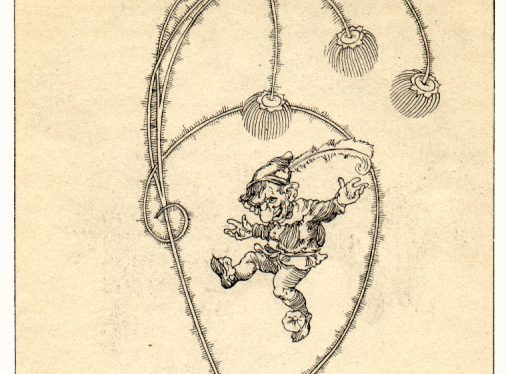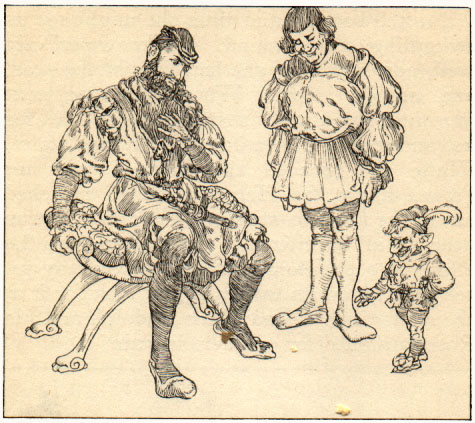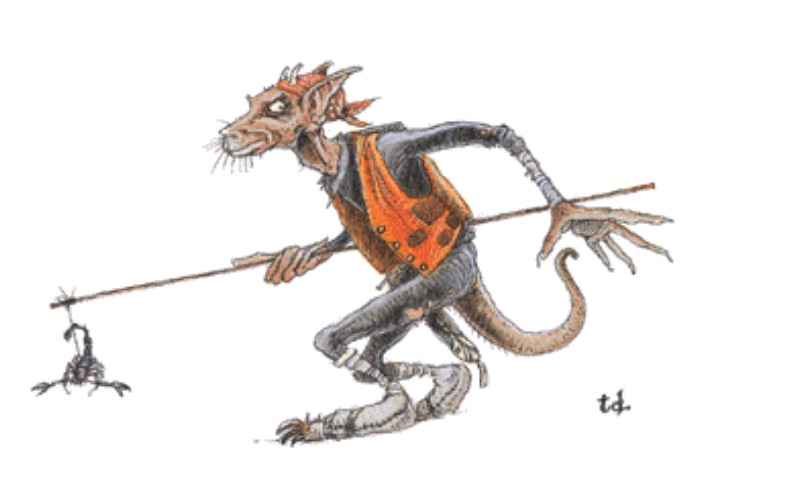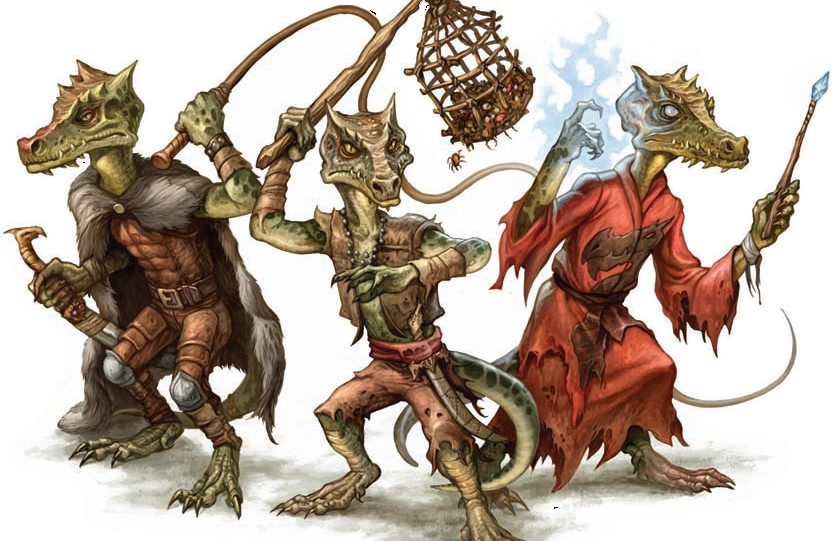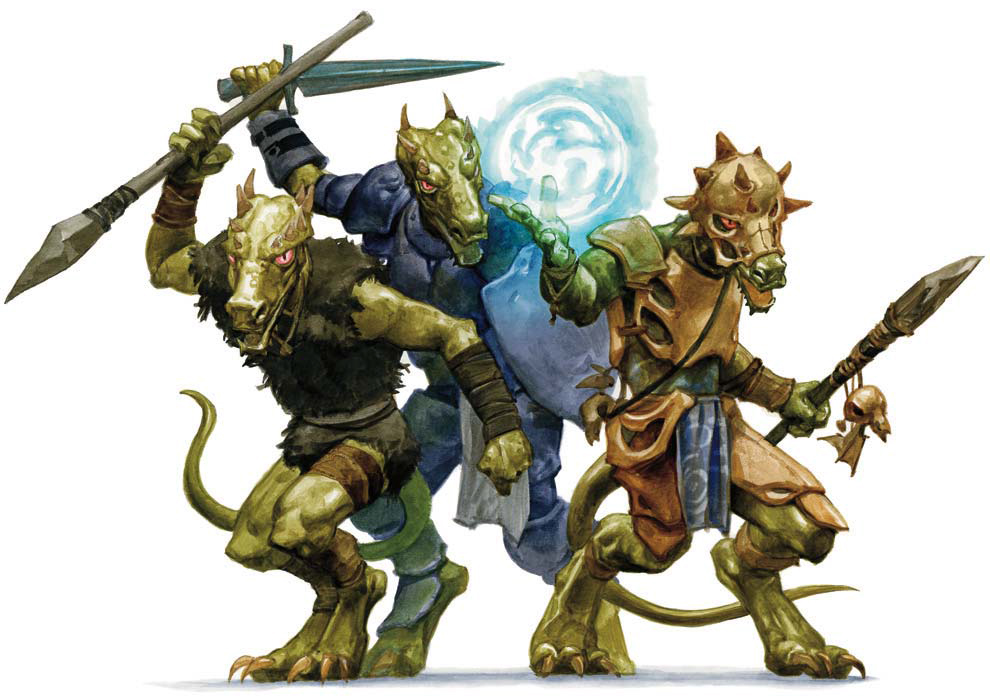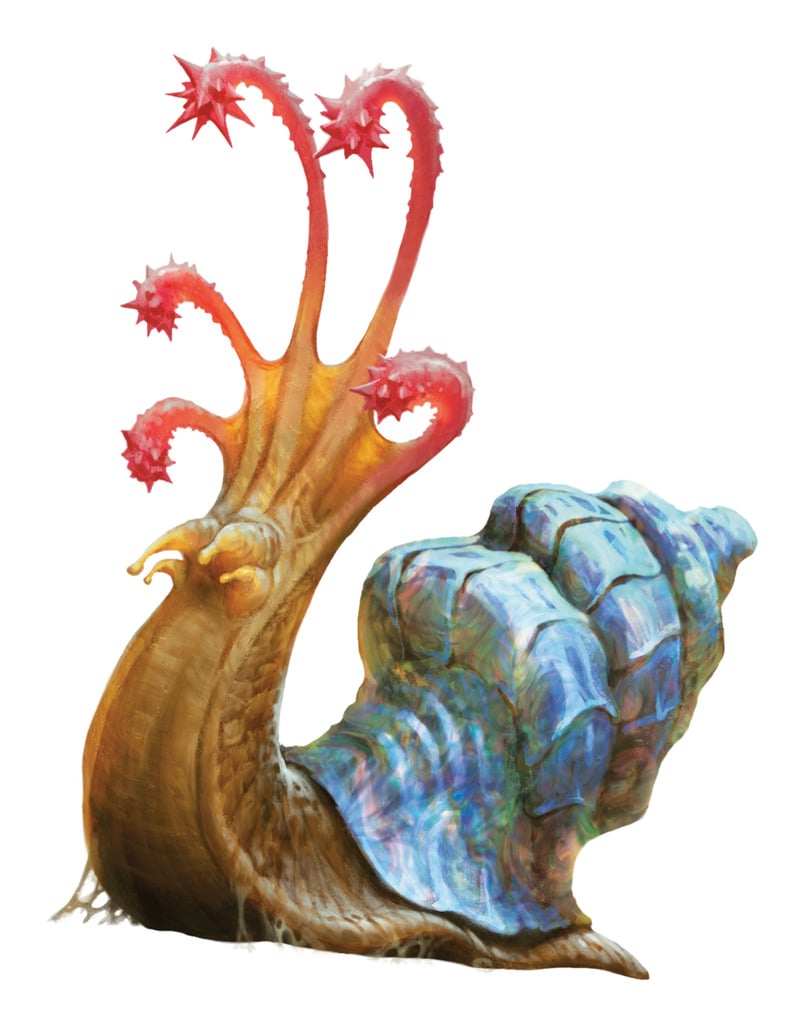Monster Spotlight: Kobolds For Days


Kobolds may occupy the bottom rung of the RPG food chain, being weaker even than Goblins, but that doesn’t mean that there cowardly little hearts aren’t in the right place. Come find out why we love Kobolds.
Kobolds are simply amazing. Whether it’s their ingenuity, their spitefulness, their bloody-minded cowardice that keeps them from ever rising above more than the servants of some other, more powerful creature while at the same time, resenting their erstwhile master for having power over them, Kobolds are a perfect monster to explore powerlessness with. Kobolds, after all, have a meta-knowledge that their place in the world is firmly under the boot of someone bigger, stronger, or smarter; Kobolds are the world’s cannon fodder.
But they endure it all because they believe, deep down, that they are the descendants from dragons. They certainly have the greed and pride of one. You can even see it in their appearance. I just hope nobody tells them about Dragonborn. Or Half-dragons. Or Dragonkin (if you’re playing in Krynn). Man, dragons really get around.
So do Kobolds, for that matter. They’ve been around since before 1st edition. Like the Tarrasque, kobolds also have their origins in real-world mythology. The “historic” kobold was a Germanic sprite, kind of like a house elf, but less servile and more…playful. So long as they were appeased.
They would quickly turn malicious as soon as they felt neglected. Much like their scaly counterparts, kobolds could be petty and vengeful when they felt turned on, playing harmless pranks like squeezing toad blood into a bishop’s dinner, beating servants, or strangling and dismembering the body of someone who refused to chastise a supposed “tormentor.”
You know, the standard Germanic folklore chart toppers.
There were famous kobolds as well. That strangling and dismembering incident got around and was attributed to the kobold Hödekin. Another one, Hinzelmann (whom you might recognize from American Gods) would demand respect, and once threatened a holy man who refused to accept Hinzelmann’s protests that he was Christian.
But all it’d take to earn their respect was a little bit of food (they loved gruel, in particular). You can see where the bloody-mindedness that informs our scaly little friends comes from.
From that guy, right there.
Granted, that kobold looks a little more like a terrifying nightmare goblin, you can still kind of see where their look came from.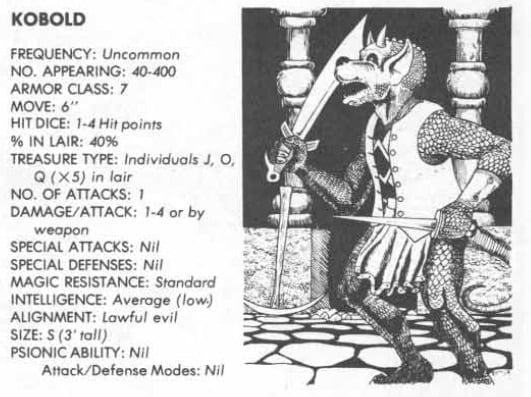
Pointy ears, check. Stylish clothing, double check. Alright, we’re good guys.
From their mythological origins as mischevious/sprites, we get the scaly little pack monsters everyone knows and loathes. They weren’t super tough, as you can see, they had only 1d4 hit points, just like a wizard.
While they weren’t very formidable on their own, you’d never run into just one. I mean look at the number appearing entry up there. 40-400. That’s not nothing. Mind you that number comes from 1st edition, when monsters had a more ecological survey kind of feel to their entries, and you’d run into noncombatants (including children).
In those early days, Kobolds had more of the murdering parts of their mythological counterparts.
And it is out of these 1st edition kobolds that we get one of my favorite pieces of gaming ephemera, Tucker’s Kobolds. Originally an editorial from Dragon 127, Tucker’s Kobolds helped shape many a growing GM’s encounter philosophy:
The kobolds caught us about 60′ into the dungeon and locked the door behind us and barred it. Then they set the corridor on fire, while we were still in it.
“NOOOOOO!!!” screamed the party leader. “It’s THEM! Run!!!”
Thus encouraged, our party scrambled down a side passage, only to be ambushed by more kobolds firing with light crossbows through murder holes in the walls and ceilings. Kobolds with metal armor and shields flung Molotov cocktails at us from the other sides of huge piles of flaming debris, which other kobolds pushed ahead of their formation using long metal poles like broomsticks. There was no mistake about it. These kobolds were bad.
Advertisement
Yup. You may have heard a version of this story around your gaming table, but essentially it shows how you can make just about anything a threat if you use it right. The core philosophy is all about “the small things used well.” It’s a real interesting read, and it gives you a good example of how you can keep things fresh and exciting during fights.
Every future iteration of the kobolds gets influenced by this.
They said choose your weapon, I said scorpion-on-a-stick, they said what?! I said GET ‘EM BITEY!
I mean he’s just waiting to use that scorpion on a stick. That scorpion is one hundred percent on board too. In 2nd Edition, Kobolds remained largely unchained. Worth a whole 7xp, they are described as a little more dog-like this go round. Their language sounds “like dogs yapping” and they smell of “damp dogs and stagnant water.” Their hatred of gnomes remains, but they became less likely to attack anything bigger unless they outnumber them. And that wasn’t just flavor text–this was back when monsters had to make morale checks, so if you managed to reduce them to a 3:2 ratio, they’d have to make a morale check or flee for their cowardly lives.
2nd Edition also introduced the first variant Kobold: the Urd–a tougher, winged kobold that flew and dropped rock bombs. These variants had actual hit dice, and had shamans and appeared in swarms large enough to justify any GM’s cry of “rocks fall, everyone dies.”
3.x and Pathfinder put the idea of variant kobolds through their engine, and spat out all manner of variants. Though they didn’t appear in the monster manuals, the published adventures were full of kobold sorcerers, rogues, fighters, and the like.
That was the beauty of those editions–you could pretty easily make any creature more of a threat, or at least to make encounters a little more dynamic. You could have a kobold rogue/assassin who went around sneak attacking and hiding in shadows, and after escaping from the party for the 4th time, took levels in monk and sorcerer too–provided you were willing to do all that work. Every time. But that’s another matter entirely, back to Kobolds.
The transition to 3rd had a few more changes as well. Kobolds shrank from 3′ to 2-2.5. They gained a racial proficiency with trapmaking and mining, reflecting their expert tunneling ability and tendency to spend their time fortifying their lands with traps and other mechanical annoyances, in a much more direct reference to Tucker’s Kobolds.
It’s even in their combat tactics–mean ideas like setting up ambushes near trapped areas, or trying to drive their enemies into other kobolds laying in wait with flaming oil or poisonous vermin ready to go. Add to that a few PC levels and the plethora of traps you could find in the DM’s guide and you had a recipe for victory. Petty, ankle-biting victory.
We leveled up in this edition.
4th Edition took that philosophy and ran with it, with an entry full of Kobold dragonshields, slingers, wyrmpriests, scale singers, scent-mongers, fishcaptains, and slyblades. Because 4th edition was more modular (most of your attacks were powers or special entries) the mechanics were able to bring out some of the personality hinted at in earlier editions.
Kobolds all became Shifty, which let them escape combat or get a little extra movement as needed, as well as gaining trap sense. Some Kobolds even gained an ability called Mob Tactics which really reinforced the idea of attacking in a kobold wave by providing a +1 bonus per kobold ally adjacent to the target.
4th edition made kobold encounters feel a little more dynamic. In one fight you could face a spellcaster, some bodyguards, and a few skirmishers–and they all fought differently, but felt like they were made to work in unison. Small things used well, right?
5th Edition includes a section entitled The Lost God which details why they hate gnomes in this edition–in the distant past, the gnomes’ god tricked the kobold’s god, Kurtulmak, into being locked in a maze forever. Because of that, the kobolds hate gnomes and pranks forever. Previous versions of this legend have the gnomes’ god collapsing Kurtulmak’s cave on him for various reasons.
Volo’s Guide to Monsters expands on this even more, characterizing Kurtulmak (and also kobolds) as arrogant and prone to gloating, with a tendency to carry grudges that end in revenge plots. In addition to devious trapmakers and expert tunnelers, Kobolds have become scavengers and cowards and it is the best thing ever:
Thanks to their lack of physical prowess and their small size, kobolds are rarely in a position to dominate other creatures, so they usually don’t have minions. Even when the opportunity presents itself, kobolds would rather not try to enslave or hire any intelligent creatures because they can’t trust such creatures to not turn on them.
Kobold characters get an ability called Grovel, Cower, and Beg, which gives your allies advantage on attack rolls against enemies within 10 feet of you while you simper and distract them. And in 5th edition all kobolds have Pack Tactics, which gives advantage on attack rolls if at least one ally is within 5 feet of the target.
Bitey?! Is that you?
Variant kobolds are present in this edition as well. Including winged kobolds (urds) and many of the ones mentioned before. There’s one in particular I’d like to highlight, the Kobold Inventor, who to me, is the epitome of the kobolds’ spiteful ingenuity The Kobold Inventor carries around a pack full of “inventions” which it can use once per day:
- A flask of acid.
- A flask of alchemist’s fire.
- A basket of centipedes–this one is great, it’s a weaponized swarm of centipedes.
- A pot full of green slime. (Did you want to take 1d10 acid damage a round or maybe have your weapon/armor destroyed?)
- A pot full of rot grubs. (Oh man, time for those disease saves!)
- SCORPION ON A STICK 2 – THE LEGEND OF BITEY’S GOLD: Poison your foes for fun and profit!
- A skunk in a cage–because not everyone needs to be a spellcaster to cast stinking cloud.
- A wasp nest in a bag. These wasps are very angry.
I’ll be honest, even though it’s not the toughest variant, this is probably my favorite kobold of any edition.
Don’t worry, you’re still my favorite monster.
Flail Snails aside, Kobolds are fantastic. There’s just something about their never-say-die…well…about their always-say-die-but-it-doesn’t-matter-we’re-awesome attitude that is kind of endearing. They capture the imagination and can make for some much needed comic relief, and a stark change of pace from fighting off rampaging hordes of gnolls or draculas or whatever. I love that they can be threatening without needing to be grim.
So whether you’re wanting to terrorize your party with traps, get caught up in a civil war over a pig, or are looking for a way to turn the most minor slight into an adventure-spanning campaign of petty revenge, you need look no further than the gnome-hating, tenacious kobolds.
Have kobolds been a thorn in your side? Your ticket to greatness? Let us know in the comments.

